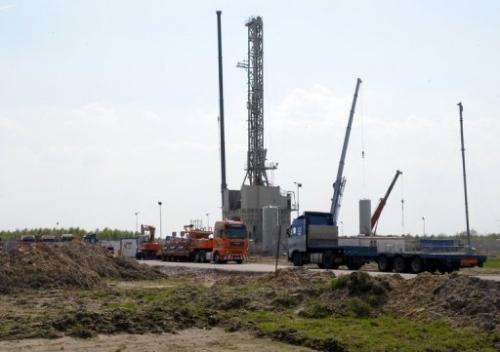A drilling rig explores for shale gas in the eastern Polish village of Grzebowilk in 2011. Poland has set it sights on building its first nuclear power station and developing shale gas, but experts believe it may soon have to choose one or the other as investing in both could prove too costly.
Poland has set it sights on building its first nuclear power station and developing shale gas, but experts believe it may soon have to choose one or the other as investing in both could prove too costly.
An EU nation of 38.2 million, Poland currently relies on its vast coal reserves to produce about 90 percent of the electricity it consumes.
Warsaw is scrambling to find alternatives to meet EU targets on reducing greenhouse gas emissions. The government also believes that tapping its own shale gas deposits could assure strategic energy independence from Soviet-era master Moscow.
Krzysztof Kilian, the chief executive of the state-owned PGE, Poland's largest utility involved in the developing both the nuclear and shale gas sectors from scratch, recently insisted "one rules out the other."
"Pursuing these two programmes at the same time cannot be crowned with success," he told delegates at a debate on Poland's energy future in Warsaw.
But centrist Prime Minister Donald Tusk was quick to respond, insisting "nuclear power and of course investments in shale gas, remain priorities."
"We'll be continuing the nuclear programme and working on developing shale gas very intensively," he said, adding that Kilian had been speaking as a company chief, not a minister or the head of government.
But his treasury minister, Mikolaj Budzanowski, recently told parliament that for now, Poland would focus on meeting its energy needs with fossil fuels.
"Regarding nuclear energy, the final decision will be made (...) in late 2014 or in early 2015," he said.
Some analysts in Warsaw believe Polish leaders are deliberately sending mixed messages to the public.
"If shale gas reserves prove sufficient, Poland will have enough energy and won't have to spend 12 billion euros on nuclear power," a recent editorial in the Rzeczpospolita broadsheet daily noted.
Others see the wisdom in Poland pursuing both atomic power and shale gas, but they warn against state companies spreading themselves too thin by investing in both sectors.
"We have to be ready for several scenarios," Pricewaterhouse Coopers expert Witold Orlowski told AFP recently, stressing that currently "no one can be certain that Poland has sufficient shale gas reserves" that are commercially viable.
But a single company "can't allow itself" to develop two different energy sectors at the same time, he noted.
Last month, four leading Polish companies led by PGE joined forces to work on plans to create a three gigawatt nuclear facility by 2024 costing between 9-12 billion euros ($11.3-15.5 billion).
And in an earlier bid to diversify Poland's energy mix, in June the same four Polish firms joined state-owned Polish oil and gas giant PGNiG in a joint venture to explore and tap the country's shale gas reserves by 2016.
Warsaw has committed 12.5 billion euros to developing the sector. Poland is believed to have up to 1.92 trillion cubic metres (67.8 trillion cubic feet) of exploitable shale gas deposits, possibly the third largest reserves in Europe behind Norway and the Netherlands, a recent state study found.
Annual natural gas consumption in the coal-rich country stands at around 14 billion cubic metres, a third of which is supplied by Russia.
Global groups Chevron, ConocoPhillips and Talisman Energy are involved in the Polish shale gas exploration programme.
Three nuclear power giants have expressed interest in building the atomic facility, including the French groups EDF and Areva, and the US and Japanese firms Westinghouse Electric and GE Hitachi Nuclear Energy Americas.
(c) 2012 AFP























